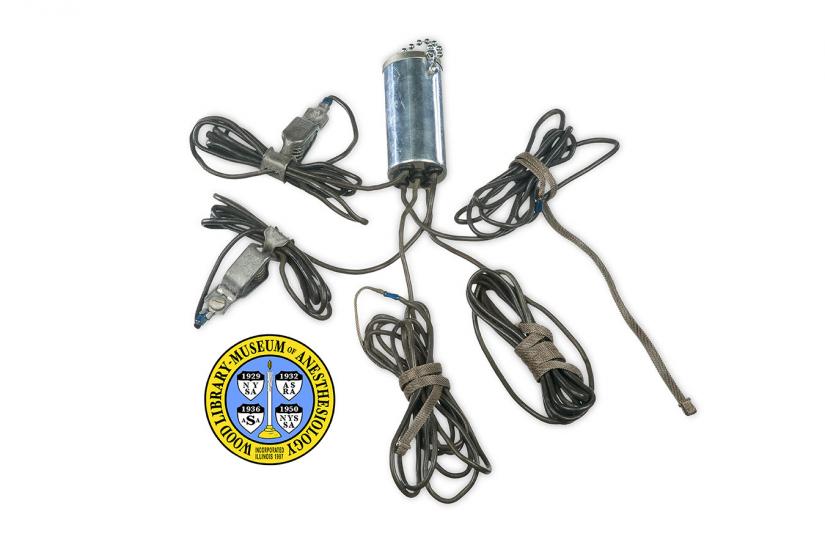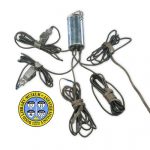Horton Intercoupler
In 1938, the Lahey Clinic created a blue-ribbon panel to investigate the causes and means of prevention of anesthetic explosions. Dr. Joseph Warren Horton (1889-1967), a biological engineer, was chosen to lead the panel. As a result of this work, he invented the Horton Intercoupler in 1939. The Intercoupler acted as a grounding device to prevent ignition of anesthetic vapors by static sparks in the operating room.
The core terminal was hung by means of a chain from either the anesthesia machine, or the operating table. When connected, one of the four wires was attached to the anesthesia machine by means of a clamp. If the operating room had a floor made of conductive material, then the clamp on the second wire would touch the floor. The other two wires end in bracelets made of metal mesh; one of these was worn by the patient, the other by the anesthesiologist.
The first new generation of non-explosive anesthetics was introduced in the 1950s. In the 1970s, standards were revised to ban flammable anesthetics were from U. S. hospitals. Safety codes continue to govern the use of oxygen and electrical equipment in medical facilities. The American Society of Anesthesiologists has served as an advisor for the creation of national fire safety codes since the 1920s.
Catalog Record: Horton Intercoupler
Access Key: aknv
Accession No.: 66-148
Title: Horton intercoupler / Ohio Chemical & Surgical Equipment Co.
Author: Horton, J. Warren, 1889-1967.
Corporate Author: Ohio Chemical and Surgical Equipment Company.
Publisher: Madison, Wisconsin : Ohio Chemical & Surgical Equipment Co., [1946-1960].
Physical Descript: 1 intercoupler : metals, plastics ; 27 x 18 x 4.5 cm. [size for storage]
Subject: Explosions – prevention and control.
Subject: Fires – prevention & control.
Subject: Health Facilities – fires and fire prevention.
Subject: Equipment Safety.
Subject: Operating Rooms – safety measures.
Web Link: https://woodlibrarymuseum.org/museum/item/661/horton-intercoupler
Note Type: General
Notes: The early year in the date range for the possible year of manufacture is
based on the year when Ohio Chemical moved to Madison, Wisconsin. The late
year in the date range for the possible year of manufacture is an estimate
based on the year that the National Fire Protection Association ceased
recommending the use of the intercoupler.
Note Type: Citation
Notes: Bause GS, Conlay LA. What is this thing? ASA Newsl. 2009;73(11):25, 51.
Note Type: Citation
Notes: Hicksox CB, Steven RJM. Explosions and fire hazards. In: Hale DE, ed.
Anesthesiology. 2nd ed. Philadelphia: F.A. Davis Co.; 1963:952-955,960.
Note Type: Citation
Notes: Tour 1. Historic Madison, Inc. of Wisconsin website. https://www.
historicmadison.org/Madison%27s%20Past/Places/Walking%20Tours/IndustrialTour1
html. Published 2013. Accessed September 12, 2013.
Note Type: Citation
Notes: Tovell RM, Friend AW. Control of physical hazards of anaesthesia. Can Med
Assoc J. June 1942;46(6):560-565.
Note Type: Citation
Notes: Woodbridge PD, Horton JW, Connell K. Prevention of ignition of anesthetic
gases by static spark. JAMA. August 26, 1939;113(9):740-744.
Note Type: Citation
Notes: Zeitlin GL. Professor Joseph Warren Horton (1889-1967): biological engineer.
J Med Biogr. 2005;13(1):39-45.
Note Type: Physical Description
Notes: One device for the prevention of the ignition of anesthetic gases by static
spark; It consists of a cylindrical metal case with five insulated high
resistance wires to equalize electrical potentials of objects and people in
the operating room; The cylindrical metal case measure approximately 7.7 cm
in length and 3.5 cm in diameter; Two metal posts extend from the side of the
case near the end with the manufacturer’s marking; Attached to these posts is
a beaded metal chain to allow the case to be hung from the OR table or from
the anesthesiologists equipment; Three of the wires have metal mesh ties at
the end for attaching to objects or people; Two of these wires measures
approximately 238 cm in length, including the mesh tie; The other measures
approximately 152 cm in length, including the mesh tie; The other two wires
end in a metal clamp; One of these wires measures approximately 152 cm,
including the clamp; The other measures approximately 124 cm, including the
clamp; One end of the case is marked by the manufacturer; The marking incudes
“[The Ohio Company logo, and a new line] Horton [new line] INTERCOUPLER [new
line] OHIO CHEMICAL & [new line] SURGICAL EQUIPMENT CO. [new line] A DIVISION
OF AIR REDUCTION COMPANY, INC. [new line] MADISON, WISCONSIN [new line] U.S.A”.
Note Type: Reproduction
Notes: Photographed by Mr. Steve Donisch on June 10, 2013.
Note Type: Historical
Notes: Introduced in 1939, this device connected and equalized the electrostatic
charge of the patient, operating table, anesthesiologist and anesthesia
machine. It was one of the devices used in the operating room that could help
prevent sparks from static electricity. This was an especially important
safety device when the inhalation anesthetics used, such as ether, ethylene
and cyclopropane, were flammable.
It was designed by biological engineer Joseph Warren Horton (1889-1967) after
he led an investigation into a fatal explosion that occurred despite the use
of recommended safety practices. Other safety practices employed at the time
included the use of grounding devices, conductive flooring and footwear, and
humidifiers. In the late 1950s, after the introduction of non-flammable
anesthetics, the need for the Horton Intercoupler began to diminish.
Horton remained involved in work to prevent operating room explosions and
became a recognized expert on the subject. His research focus changed in 1941
before the U.S. entered WW II, when he became involved in the design and
development of instruments for sonar.
Note Type: Publication
Notes: Code for Use of Flammable Anesthetics: Safe Practice for Hospital Operating
Rooms. Boston: National Fire Protection Association; 1960. NFPA; no. 56.
Note Type: Exhibition
Notes: Chosen for the WLM website (noted September 10, 2013).


